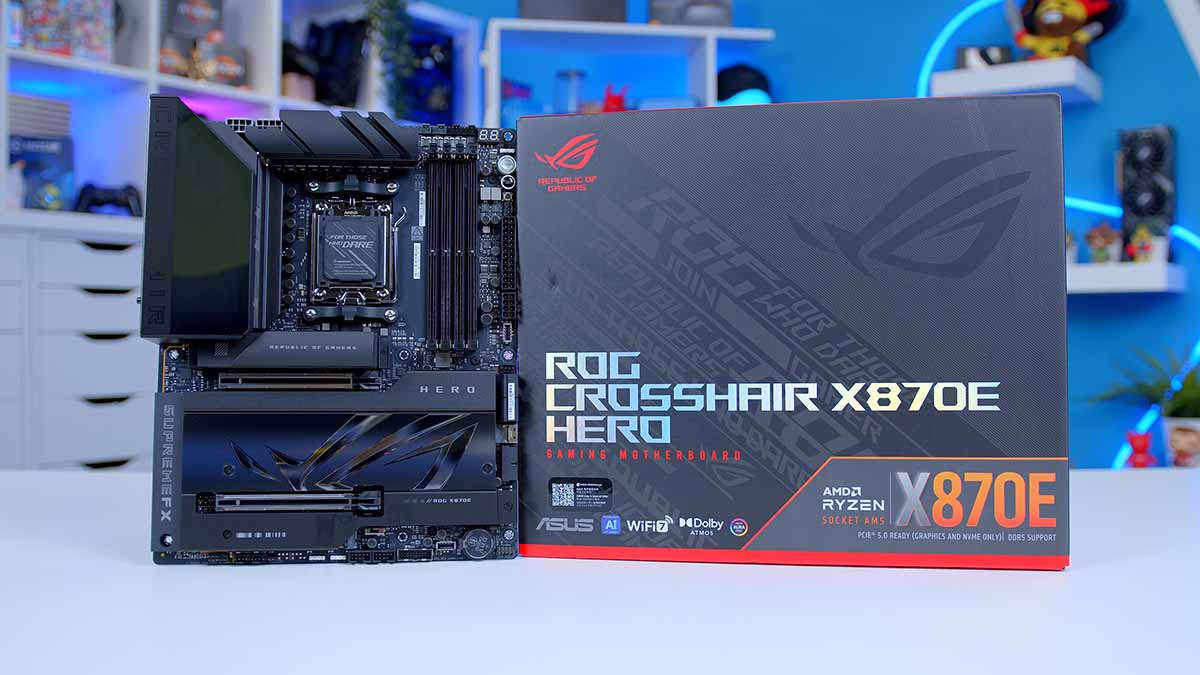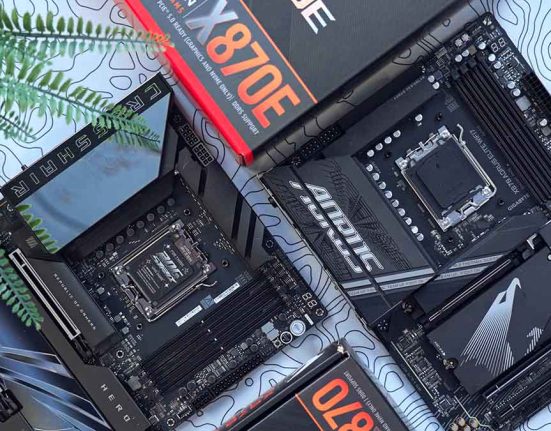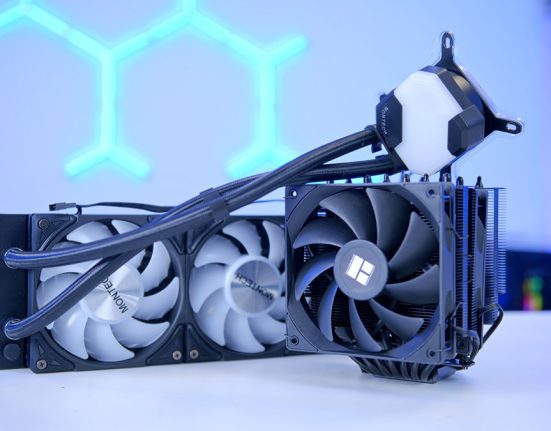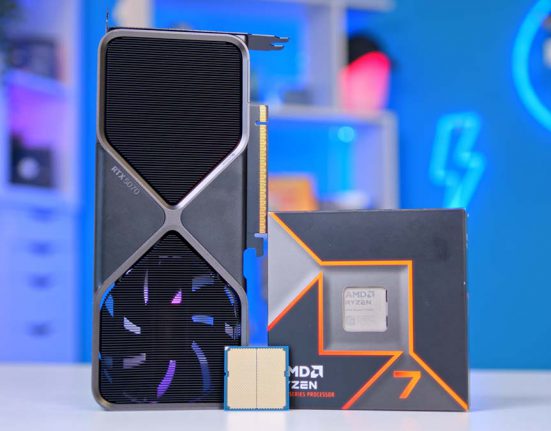The ASUS ROG CROSSHAIR X870E HERO is a flagship motherboard launched in September 2024, around a month after the release of the Ryzen 9000 CPUs. Much like its X670E counterpart, the X870E HERO is primarily aimed at enthusiasts looking to maximise performance across gaming and more burdensome multi-core workloads. With strong overclocking support and ASUS NITROPATH technology for DDR5 RAM, the X870E HERO is built for a top-end PC build. Because this board is geared towards Ryzen 9000 options, we’ve tested and analysed the X870E HERO to see what benefits it offers to those building a Ryzen 9000 PC.
One of the main things we’ve noticed with our X870 reviews is that these new variants offer some significant upgrades compared to their X670 predecessors. Widespread Gen5 support, high-speed IO, improved networking, and more usability features are qualities we’ve seen become standard across all of these designs. However, we’re curious to know where the X870E HERO stands compared to the X670E version, as the previous generation board is jam-packed with great features. This puts into question the value of the latest variant.
This article examines the ROG CROSSHAIR X870E HERO in-depth, examining its overall design, box accessories, features, and more. This gives us an idea of the value on offer compared to other X870E motherboards.
Buy the ASUS ROG CROSSHAIR X870E HERO on:
Specification
Much like the ROG Strix X870E-E Gaming WiFi, the specs of the CROSSHAIR X870E HERO make it incredibly clear that it is an enthusiast-level motherboard. This X870E motherboard has retained the same ATX form factor as its X670E counterpart. While some would appreciate this being an E-ATX board, the size of these boards can pose clearance issues in mid-tower cases, as they aren’t always supported.
The CROSSHAIR X670E HERO and X870E HERO are similar regarding overclocking. The X870E HERO board has received a 600 MT/s increase in RAM overclocking, likely due to NITROPATH technology. VRAM power phases, however, haven’t changed, with the X870E HERO retaining an 18+2+2 configuration. While the hardware hasn’t changed, under the hood, ASUS has added AI enhancements that make overclocking much more accessible in the BIOS.

On the expansion front, the CROSSHAIR X870E HERO has two Gen5 graphics card slots, the same as its X670E version. Storage has improved, with this board featuring five dedicated slots (three Gen5 and two Gen4) instead of an expansion card to bolster the number of options. Providing these slots on the board, rather than using an expansion card, frees up space for those looking to increase I/O options or utilise a dual-GPU setup.
| Specification | ASUS ROG CROSSHAIR X870E HERO |
|---|---|
| Form Factor | ATX |
| Supported Memory | 192GB DDR5 8600MT/s |
| PCI-E x16 Slots | 2 x PCI-E 5.0 |
| PCI-E x4 Slots | 3 x PCI-E 5.0 2 x PCI-E 4.0 |
| VRM Power Phases | 18+2+2 |
| Front IO | 2 x USB 3.2 Gen2x2 Type-C 2 x USB 3.2 Gen1 Type-A 2 x USB 2.0 |
| Rear IO | 2 x USB4 Type-C 6 x USB 3.2 Gen2 Type-A 2 x USB 3.2 Gen2 Type-C |
| Audio | 1 x Optical S/PDIF 2 x Audio Jacks |
| Networking | 2.5 Gigabit LAN 5 Gigabit LAN WiFi 7 |
IO is typically where most top-end motherboards thrive, offering more than enough connectivity for plenty of peripherals or external drives. For front panel ports, builders can access two USB 3.2 Gen2x2 Type-C headers, two USB 3.2 Gen1 headers offering support for up to four ports, and two USB 2.0 headers supporting four ports. It’s worth noting that the primary USB-C header provides 60W power delivery or QC4+ charging.
Strangely, the X870E HERO has received a bit of a downgrade on the rear. The X670E HERO motherboard has twelve ports, while the X870E version only has ten. This won’t be a deal-breaker for most prospective buyers, but it seems like an odd change to include fewer ports. Regardless, the X870E has access to two USB4 Type-C ports and eight USB 3.2 Gen2 ports, two of which are also Type-C.
This board has a dual-LAN networking setup, including a 2.5 and 5 Gigabit LAN port. It is also followed by WiFi 7, which offers better speeds and stability if you have a supporting router. It’s nice to see dual-LAN on a top-end board, as some enthusiasts with a home server setup are likely to use the higher-speed port for file transfers. Finally, this board has two 3.5mm jacks and an optical S/PDIF port for audio. It’s nice to see optical out, but again, compared to the X670E HERO, there are three fewer ports on this board, which is a shame.
What’s in the Box?
In all of our motherboard reviews, we examine what comes in the box. Manufacturers typically provide extra cables or gadgets that streamline the building process, so we’ll look at those now!
First up is the WiFi 7 antenna. WiFi 7 is the new standard on X870 motherboards, and if you have a router that supports it, it will bring better speeds and stability. With this standard shift, the WiFi antennas have also changed. They all use a quick connect mechanism to wire the WiFi 7 antenna to the IO.

Similar to the other high-end ASUS motherboards we’ve reviewed, the ROG CROSSHAIR X870E HERO comes with SATA data cables for those with older SATA storage devices, the Q-connectors, Q-Latches, and Q-Slide. All the ‘Q’ items are tool-less accessories that significantly streamline the building process. For example, the Q-Slides are particularly useful if you have M.2 drives of different sizes.

There are a couple of extra accessories worth noting. One of which is the RGB extension cable. The cable in the box uses the 3-pin standard for addressable RGB, providing more reach for shorter cables.

ASUS includes a USB driver, which comes with drivers and utilities. This is handy for those installing from scratch. Wiping a drive will often remove any WiFi and Ethernet drivers, so having this is handy for those without an additional device with access to the internet for drivers and updates.

Finally, you’ll find a novelty ASUS-themed bottle opener. This doesn’t add anything to the build per se, but it’s a unique gift that adds to the experience of buying this board.

ASUS ROG CROSSHAIR X870E HERO Design
The ASUS ROG CROSSHAIR X870E HERO is an entirely black motherboard all the way down to the PCB. All of the heatsinks that cover the underlying metal are black, with a matte finish on most of them, except for the larger heatsink towards the middle of the board. The overall aesthetic is much more reminiscent of the older Dark Hero boards that ASUS offered for the Ryzen 5000 range. For this reason, I’m a big fan of the look.

Many modern motherboards tend to toe the line with darker-themed motherboards, with the majority offering a lighter heatsink or IO cover to brighten the look. However, the X870E HERO is genuinely black and has a much more streamlined design compared to other boards we’ve looked at.
Some heatsinks have a few bits of ROG livery but nothing too aggressive or offputting. Even the shinier ROG logo in the middle of the heatsinks looks excellent. The dark design looks and feels highly sophisticated.

The rear IO heatsink has a dedicated RGB panel that lights up when the board is powered on. It’s nice to see a larger area dedicated to RGB on the rear IO, which can be easily customised using the Armory Crate software. It’s worth highlighting that this isn’t a screen, so it can only be customised with RGB effects.

I’m a big fan of the overall design of the ROG CROSSHAIR X870E HERO. I feel the board would benefit from more heatsinks to hide away the rugged texture of the PCB. However, this isn’t a deal-breaker for me. The board is entirely black, and the overarching dark design feels much more consistent than other boards that use grey or white to lighten the look, which doesn’t always look great.
Connectivity Options
Graphics Card Slots
On the ASUS ROG CROSSHAIR X870E HERO, you’ll find two Gen5 graphics card slots. One is directly beneath the primary SSD slot, and the other is slightly further down, closer to the bottom of the board. While Gen5 GPU slots don’t have much use yet, they provide upgradeability for those looking to pick up the next generation of GPUs, which will likely utilise Gen5 bandwidth.

Additionally, these slots offer enthusiasts more expansion for those looking to increase storage or USB ports with an expansion card. Again, the type and number of slots haven’t changed compared to the X670E version, but it’s good to see that there isn’t a downgrade here.
M.2 Slots
The ROG CROSSHAIR X870E HERO has five SSD slots on the board, compared to the X670E version, which only had four but comes with an expansion card. These slots are comprised of three Gen5 slots and two Gen4. The first Gen5 sits underneath the large heatsink towards the top of the board, which is easily removed thanks to the Q-Release button.

The rest of the drive slots are underneath the large heatsink towards the middle of the board. Unfortunately, the heatsink isn’t tool-less and can be removed once the four screws are loosened.

Each drive has a dedicated thermal pad. This is a nice touch, as it will help the drives keep thermals under control and dissipate heat better.

RAM DIMMs
The ROG CROSSHAIR X870E HERO RAM configuration is relatively standard for an ATX motherboard. It supports a maximum capacity of 192GB, but we may see this increase to 256GB with future BIOS updates. RAM speeds can be overclocked to 8600MT/s with Ryzen 8000 CPUs, while Ryzen 9000 supports a max speed of 8200MT/s. This is all thanks to the NITROPATH technology, which has improved the RAM connectivity and pathways to minimise interference.

This is one of the only motherboards thus far that use NITROPATH to improve RAM speeds. The only other board is the ROG Strix X870E-E Gaming WiFi, a similar enthusiast-level option.
Rear IO
As mentioned in this article’s specs section, the ROG CROSSHAIR X870E HERO has a pretty bountiful set of rear IO. Although the amount of IO has been downgraded compared to the X670E chipset version, it’s still a solid offering. There are ten ports in total, eight USB 3.2 Gen2 ports and two USB4 ports. Networking is great. As I said earlier, it’s nice to see dual-LAN support. Audio could be better, but including optical S/PDIF opens up options for those with a soundbar or speakers.

WiFi 7 will be a bit pointless for some, primarily because this standard hasn’t properly saturated the market, which means few devices even support it. However, the speeds are incredible if you’ve picked up a WiFi 7 router.
Internal Headers
CPU and Motherboard Power
Looking at the internal headers, things get a little bit more interesting. The motherboard’s power uses the standard 24-pin connector, but an additional PCI-E 8-pin is directly underneath it. This boosts power delivery for overclocking, helping spread the power evenly. We rarely see the additional 8-pin, but this makes the ROG CROSSHAIR X870E HERO unique in its offering.

CPU power is, again, standard for a board of this calibre. Builders have access to two 8-pin EPS CPU connectors, which is enough to provide plenty of juice for overclocking.

Front USB Headers
The front USB options aren’t very impressive, but plenty of headers are here for better expansion and upgradeability. These headers are for the USB ports on the front of your case. USB-C is located underneath the secondary motherboard header.

Just off to the right in this image is a right-angled USB 3.0 port, followed by an additional Type-C port. The USB 3 headers support up to a maximum of two ports each. The other is located at the bottom of the board next to USB2.

Pump and Fan Headers
There are plenty of options for pump and fan headers to support any additional coolers or extra fans around the case. The main four are located at the top of the motherboard. From left to right, these are ‘CPU_OPT’, ‘CPU_FAN’, ‘AIO_PUMP’, and’ CHA_FAN2′. These are all 4-pin PWM headers.

The rest of the headers are relatively dispersed around the rest of the motherboard. There are four extra ‘CHA_FAN’ headers, one at the bottom left, next to ‘HD_Audio’. Next to this is a ‘W_PUMP+’ header. The rest are situated on the right-hand side.

RGB Headers
This board offers three 3-pin addressable RGB headers. Two are at the bottom, while one sits at the top near the Q-Code display. Ultimately, this board could net itself a strong value position if it offered more ARGB headers. However, three will be more than ample for most builders, especially if you have splitters.

SATA Data Ports
SATA data isn’t generally used as much due to M.2 SSDs becoming much more affordable. However, those with SATA drives will find four ports to plug their storage into. These are right-angled, and I think four is more than enough, considering how old this interface is.

Building with the ROG CROSSHAIR X870E HERO
So far, building with all of the ASUS X870 motherboards has been a breeze. Most of the stack utilises an ATX form factor, so the majority of cases generally support them. This means we don’t have to move around standoffs or pick out an absurdly large case to install the board. Additionally, the sheer usability features these boards offer means that many component installs are tool-less.
For example, installing an SSD in the primary slot is as simple as pressing a button, slotting in the drive, pushing it down and putting the heatsink back on. With no screws required. This is a feature we would love to see across more boards, which makes the ROG CROSSHAIR X870E HERO a competitive offering compared to the rest of the market.
Adding an integrated rear IO shield is a nice touch, but we wouldn’t expect anything less for a board priced this high. My only qualm with this board from a building point of view is that the larger heatsink in the middle of the board isn’t tool-less. Instead, it can be removed by loosening four screws.
While this is standard for most boards, we expect a little more for motherboards priced at $500 or more. Plus, when you have boards like the Gigabyte B650E AORUS Stealth ICE providing this exact feature, there isn’t an argument not to offer something similar.
Features We Like
Usability Features
We’ll keep this brief, as we’ve highlighted this feature across most of our ASUS X870 coverage. The usability features are excellent. They streamline the building process, minimise the use of tools, and are incredibly innovative. We need to see more features like this from other manufacturers.

Better Overclocking Support
While the amount of power phases has remained the same between generations, ASUS has significantly changed and improved overclocking for Ryzen 9000 CPUs under the hood. Including the 8-pin PCI-E motherboard power connector significantly increases power delivery, and the number of BIOS features allows enthusiasts to utilise PBO and crank clock speeds to the maximum.

Features We Don’t Like
Rear IO is a Downgrade Versus X670E Version
Weirdly, the rear IO has been downgraded compared to the previous X670E version of this motherboard. There are fewer USB ports and audio options. While this won’t be an issue for some, especially as there’s an extra networking option compared to the X670E Hero, it’s a shame to see less IO overall, especially for those with more advanced audio setups.

Conclusion
ASUS ROG CROSSHAIR X870E HERO

Product Name: ROG CROSSHAIR X870E HERO
Brand: ASUS
-
Features
-
Design
-
Performance
-
Value For Money
Summary
The ASUS ROG CROSSHAIR X870E HERO is a genuine enthusiast-level motherboard designed to offer builders the best of the best when it comes to features, connectivity, expansion and sheer performance. This board has received significant upgrades compared to its predecessor, the X670E HERO. There are substantial improvements to overclocking, more SSD slots, more robust networking options, and a host of usability features designed to streamline and simplify the building process. Furthermore, this board has received the ‘Dark Hero’ treatment and features an entirely black design from head to toe, with plenty of heatsinks and dedicated RGB on top of the rear IO heatsink.
My only major qualms with this board are the lack of audio options on the rear IO and the lack of a tool-less mechanism for the large heatsink. Enthusiasts with more complex audio setups are missing out, as this board only offers a simple set of 3.5mm in and out jacks alongside optical S/PDIF. Additionally, I feel the large heatsink in the centre of the board would benefit from being tool-less, further offering prospective buyers unique features that would make it stand out more. However, these are relatively minor caveats considering the strengths of this board, and we would still recommend it for a top-end PC build regardless.
Pros
✅ Gorgeous design
✅ DIY-friendly features
✅ Overclocking support
Cons
❌ Downgraded IO
❌ No tool-less heatsink
❌ Very expensive



![MPI_[DP055] SAMA V60 + 9070 Build Montage](https://geekawhat.com/wp-content/uploads/2025/12/FI_DP055-SAMA-V60-9070-551x431.jpg)



![FI_[DM78] Corsair Air 5400 + 5090 Gaming PC Build](https://geekawhat.com/wp-content/uploads/2025/11/FI_DM78-Corsair-Air-5400-5090-Gaming-PC-Build-551x431.jpg)
